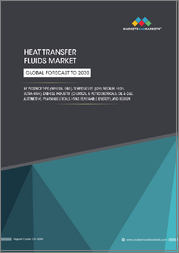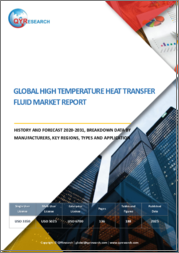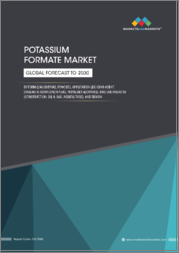
|
시장보고서
상품코드
1675587
세계의 열전달유체(HTF) 시장 : 유형별, 최종사용자별, 지역별(2025-2033년)Heat Transfer Fluids Market Report by Type, End User, and Region 2025-2033 |
||||||
열전달유체(HTF) 시장 세계 시장 규모는 2024년 116억 달러에 달했습니다. 향후 IMARC Group은 이 시장이 2033년까지 173억 달러에 도달하여 2025년부터 2033년까지 4.31%의 연평균 성장률(CAGR)을 나타낼 것으로 예상하고 있습니다. 시장 성장의 주요 요인은 전기자동차 및 전자기기에서 최적의 열 관리를 위한 첨단 열전달유체(HTF)에 대한 수요 증가, 다양한 산업 공정에서 에너지 효율에 대한 수요 증가, 친환경 열전달유체(HTF)의 급속한 활용 등으로 분석됩니다.
열전달유체(HTF)는 한 시스템에서 다른 시스템으로 열을 전달하는 액체 또는 증기 형태의 화학 물질을 말합니다. 이들은 고도로 정제된 석유, 합성으로 제조된 탄화수소 또는 실리콘을 사용하여 제조됩니다. 주로 열원에서 다른 열 수요 또는 냉류로 열을 전달하는 중간 유체로 사용됩니다. 과열을 방지하고 열에너지의 저장을 용이하게 합니다. 또한 낮은 시스템 압력에서 고온을 제공하고, 낮은 점도, 비부식성, 높은 열전도율 및 확산성, 긴 작동 수명 등 여러 가지 장점이 있습니다. 그 결과, HTF는 석유 및 가스, 자동차, 화학, 재생에너지, 제약 등 많은 산업 분야의 처리 설비에서 리보일러, 커패시터, 재생기, 열교환 시스템에 널리 사용되고 있습니다.
열전달유체(HTF) 시장 동향 :
HTF는 태양전지판에서 에너지를 수집하여 에너지 저장 시스템으로 운반하는 데 도움을 주며, 저장된 에너지는 발전용으로 사용됩니다. 그 결과, 집광형 태양광 발전(CSP) 플랜트의 채택이 증가하고 있는 것이 시장 성장을 가속하는 주요 요인으로 작용하고 있습니다. 또한, 가스 감미화, 글리콜 탈수, 분별 등 천연 가스 처리의 다양한 단계에서 HTF의 사용이 증가하고 있습니다. 이에 따라 분별장치의 리보일러 및 오버헤드 냉각 커패시터의 가열 매체로 정제 공정에서 제품 이용이 증가함에 따라 HTF 수요가 증가하고 있습니다. 이는 에너지 수요 증가로 인한 석유 및 가스 부문의 급격한 성장에 힘입은 바도 있습니다. 이 외에도 식품 첨가물 제조, 식물성 기름 탈취, 식품 포장 제조를 위한 식품 가공 시설의 가열 및 냉각 용도로 HTF의 사용이 증가하면서 시장 성장의 촉매제가 되고 있습니다. 또한, HTF는 자동차 엔진의 라디에이터 시스템에서 방열 냉각액으로 널리 사용되고 있습니다. 이와 함께 화학 분야의 공정 유체 및 폴리머의 간접 가열, 단일 유체 배치 처리, 저압 열병합 발전, 벌크 재료의 건조 및 가열, 가스 처리 등에서의 제품 사용량 증가가 시장 성장을 가속하고 있습니다. 에너지 절약에 대한 수요 증가, HVAC 및 냉동 시스템에서의 제품 사용 증가, 자동차 생산 및 판매 급증, CSP 플랜트에 대한 정부 자금 지원 증가 등 다른 요인들도 시장 전망을 밝게 하고 있습니다.
본 보고서에서 다룬 주요 질문
- 세계 열전달유체(HTF) 시장은 지금까지 어떻게 성장해 왔는가?
- 세계 열전달유체(HTF) 시장 성장 촉진요인, 저해요인, 기회요인은 무엇인가?
- 세계 열전달유체(HTF) 시장에 미치는 각 촉진요인, 억제요인 및 기회의 영향은?
- 주요 지역 시장은?
- 가장 매력적인 열전달유체(HTF) 시장은 어느 국가인가?
- 유형별 시장 분석은?
- 열전달유체(HTF) 시장에서 가장 매력적인 유형은?
- 최종사용자별 시장 분석은?
- 열전달유체(HTF) 시장에서 가장 매력적인 최종 사용자는?
- 세계 열전달유체(HTF) 시장 경쟁 구도는?
- 세계 열전달유체(HTF) 시장의 주요 기업은?
목차
제1장 서문
제2장 조사 범위와 조사 방법
- 조사 목적
- 이해관계자
- 데이터 소스
- 1차 정보
- 2차 정보
- 시장 추정
- 보텀업 접근
- 톱다운 접근
- 조사 방법
제3장 주요 요약
제4장 서론
- 개요
- 주요 업계 동향
제5장 세계의 열전달유체(HTF) 시장
- 시장 개요
- 시장 실적
- COVID-19의 영향
- 시장 예측
제6장 시장 분석 : 유형별
- 광유
- 합성 유체
- 글리콜
- 기타
제7장 시장 분석 : 최종사용자별
- 화학제품
- 석유 및 가스
- 식품 및 음료
- 제약
- 재생에너지
- 자동차
- HVAC 및 냉장
- 기타
제8장 시장 분석 : 지역별
- 북미
- 미국
- 캐나다
- 아시아태평양
- 중국
- 일본
- 인도
- 한국
- 호주
- 인도네시아
- 기타
- 유럽
- 독일
- 프랑스
- 영국
- 이탈리아
- 스페인
- 러시아
- 기타
- 라틴아메리카
- 브라질
- 멕시코
- 기타
- 중동 및 아프리카
- 시장 내역 : 국가별
제9장 촉진요인 및 억제요인·기회
- 개요
- 성장 촉진요인
- 성장 억제요인
- 기회
제10장 밸류체인 분석
제11장 Porter의 Five Forces 분석
- 개요
- 바이어의 교섭력
- 공급 기업의 교섭력
- 경쟁 정도
- 신규 진출업체의 위협
- 대체품의 위협
제12장 가격 분석
제13장 경쟁 구도
- 시장 구조
- 주요 기업
- 주요 기업 개요
- Arkema S.A.
- BASF SE
- Chevron Corporation
- Clariant AG
- Dalian Richfortune Chemicals Co. Ltd.
- Dow Inc.
- Dynalene Inc.
- Eastman Chemical Company
- Exxon Mobil Corporation
- Hindustan Petroleum Corporation Ltd.(Oil and Natural Gas Corporation)
- Indian Oil Corporation Ltd.
- Phillips 66 Company
- Radco Industries Inc.
- Shell plc
- TotalEnergies SE
The global heat transfer fluids market size reached USD 11.6 Billion in 2024. Looking forward, IMARC Group expects the market to reach USD 17.3 Billion by 2033, exhibiting a growth rate (CAGR) of 4.31% during 2025-2033. The market growth is primarily driven by the growing need for sophisticated heat transfer fluids in electric vehicles and electronics for optimal thermal management, the increasing demand for energy efficiency in various industrial processes, and the rapid utilization of environmentally friendly heat-transfer fluids.
Heat transfer fluids (HTFs), or thermic fluids, refer to chemicals in liquid or vapor form that transfer heat from one system to another. They are manufactured using highly refined petroleum, synthetically formulated hydrocarbons, or silicone. They are mainly employed as an intermediate fluid to transmit heat from a heat source to other heat demands or cold streams. They assist in preventing overheating and facilitate the storage of thermal energy. They also offer high temperatures at low system pressures and provide several benefits, such as low viscosity, non-corrosive nature, high thermal conductivity and diffusivity, and prolonged operating lifetimes. As a result, HTFs find extensive applications in the reboiler, condenser, regenerator, and heat exchanging systems across the processing facilities of numerous industries, including oil and gas, automotive, chemical, renewable energy, and pharmaceutical.
Heat Transfer Fluids Market Trends:
HTFs aid in collecting energy from the solar field and transporting it to the energy storage systems, wherein the stored energy is used for electricity generation. Consequently, the increasing adoption of concentrated solar power (CSP) plants represents the primary factor driving the market growth. Additionally, there is a rise in the use of HTFs during various stages of natural gas processing, such as gas sweetening, glycol dehydration, and fractionation. In line with this, the growing product utilization in the refining processes as a medium for heating reboilers of fractionation units and overhead cooling condensers has augmented the demand for HTFs. This is further supported by rapid growth in the oil and gas sector due to the escalating energy demand. Besides this, the increasing usage of HTFs in heating and cooling applications at food processing facilities for food additive manufacturing, vegetable oil deodorizing, and food packaging production has catalyzed market growth. Furthermore, there has been widespread adoption of HTFs as heat-dissipating coolant fluid in the radiator systems of vehicle engines. Along with this, the rising product usage in the chemical sector for indirect heating of process liquids and polymers, single fluid batch processing, low-pressure cogeneration, drying and heating of bulk materials, and gas processing has propelled the market growth. Other factors, including the growing need for energy conservation, increasing product applications in HVAC and refrigeration systems, escalating automobile production and sales, and rising government funding for CSP plants, are also creating a favorable market outlook.
Key Market Segmentation:
Type Insights:
- Mineral Oils
- Synthetic Fluids
- Glycols
- Others
End User Insights:
- Chemical
- Oil and Gas
- Food and Beverages
- Pharmaceutical
- Renewable Energy
- Automotive
- HVAC and Refrigeration
- Others
Regional Insights:
- North America
- United States
- Canada
- Asia-Pacific
- China
- Japan
- India
- South Korea
- Australia
- Indonesia
- Others
- Europe
- Germany
- France
- United Kingdom
- Italy
- Spain
- Russia
- Others
- Latin America
- Brazil
- Mexico
- Others
- Middle East and Africa
- The report has also provided a comprehensive analysis of all the major regional markets, which include North America (the United States and Canada); Asia-Pacific (China, Japan, India, South Korea, Australia, Indonesia, and others); Europe (Germany, France, the United Kingdom, Italy, Spain, Russia, and others); Latin America (Brazil, Mexico, and others); and the Middle East and Africa. According to the report, Asia Pacific was the largest market for heat transfer fluids. Some of the factors driving the Asia Pacific heat transfer fluids market included the significant growth in the pharmaceuticals and chemical processing industries, increasing adoption of concentrated solar power, easy availability of base stock, etc.
Competitive Landscape:
- The report has also provided a comprehensive analysis of the competitive landscape in the global heat transfer fluids market. Competitive analysis such as market structure, market share by key players, player positioning, top winning strategies, competitive dashboard, and company evaluation quadrant has been covered in the report. Also, detailed profiles of all major companies have been provided. Some of the companies covered include Arkema S.A., BASF SE, Chevron Corporation, Clariant AG, Dalian Richfortune Chemicals Co. Ltd., Dow Inc., Dynalene Inc., Eastman Chemical Company, Exxon Mobil Corporation, Hindustan Petroleum Corporation Ltd. (Oil and Natural Gas Corporation), Indian Oil Corporation Ltd., Phillips 66 Company, Radco Industries Inc., Shell plc, TotalEnergies SE, etc.
Key Questions Answered in This Report:
- How has the global heat transfer fluids market performed so far, and how will it perform in the coming years?
- What are the drivers, restraints, and opportunities in the global heat transfer fluids market?
- What is the impact of each driver, restraint, and opportunity on the global heat transfer fluids market?
- What are the key regional markets?
- Which countries represent the most attractive heat transfer fluids market?
- What is the breakup of the market based on the type?
- Which is the most attractive type in the heat transfer fluids market?
- What is the breakup of the market based on the end user?
- Which is the most attractive end user in the heat transfer fluids market?
- What is the competitive structure of the global heat transfer fluids market?
- Who are the key players/companies in the global heat transfer fluids market?
Table of Contents
1 Preface
2 Scope and Methodology
- 2.1 Objectives of the Study
- 2.2 Stakeholders
- 2.3 Data Sources
- 2.3.1 Primary Sources
- 2.3.2 Secondary Sources
- 2.4 Market Estimation
- 2.4.1 Bottom-Up Approach
- 2.4.2 Top-Down Approach
- 2.5 Forecasting Methodology
3 Executive Summary
4 Introduction
- 4.1 Overview
- 4.2 Key Industry Trends
5 Global Heat Transfer Fluids Market
- 5.1 Market Overview
- 5.2 Market Performance
- 5.3 Impact of COVID-19
- 5.4 Market Forecast
6 Market Breakup by Type
- 6.1 Mineral Oils
- 6.1.1 Market Trends
- 6.1.2 Market Forecast
- 6.2 Synthetic Fluids
- 6.2.1 Market Trends
- 6.2.2 Market Forecast
- 6.3 Glycols
- 6.3.1 Market Trends
- 6.3.2 Market Forecast
- 6.4 Others
- 6.4.1 Market Trends
- 6.4.2 Market Forecast
7 Market Breakup by End User
- 7.1 Chemical
- 7.1.1 Market Trends
- 7.1.2 Market Forecast
- 7.2 Oil and Gas
- 7.2.1 Market Trends
- 7.2.2 Market Forecast
- 7.3 Food and Beverages
- 7.3.1 Market Trends
- 7.3.2 Market Forecast
- 7.4 Pharmaceutical
- 7.4.1 Market Trends
- 7.4.2 Market Forecast
- 7.5 Renewable Energy
- 7.5.1 Market Trends
- 7.5.2 Market Forecast
- 7.6 Automotive
- 7.6.1 Market Trends
- 7.6.2 Market Forecast
- 7.7 HVAC and Refrigeration
- 7.7.1 Market Trends
- 7.7.2 Market Forecast
- 7.8 Others
- 7.8.1 Market Trends
- 7.8.2 Market Forecast
8 Market Breakup by Region
- 8.1 North America
- 8.1.1 United States
- 8.1.1.1 Market Trends
- 8.1.1.2 Market Forecast
- 8.1.2 Canada
- 8.1.2.1 Market Trends
- 8.1.2.2 Market Forecast
- 8.1.1 United States
- 8.2 Asia-Pacific
- 8.2.1 China
- 8.2.1.1 Market Trends
- 8.2.1.2 Market Forecast
- 8.2.2 Japan
- 8.2.2.1 Market Trends
- 8.2.2.2 Market Forecast
- 8.2.3 India
- 8.2.3.1 Market Trends
- 8.2.3.2 Market Forecast
- 8.2.4 South Korea
- 8.2.4.1 Market Trends
- 8.2.4.2 Market Forecast
- 8.2.5 Australia
- 8.2.5.1 Market Trends
- 8.2.5.2 Market Forecast
- 8.2.6 Indonesia
- 8.2.6.1 Market Trends
- 8.2.6.2 Market Forecast
- 8.2.7 Others
- 8.2.7.1 Market Trends
- 8.2.7.2 Market Forecast
- 8.2.1 China
- 8.3 Europe
- 8.3.1 Germany
- 8.3.1.1 Market Trends
- 8.3.1.2 Market Forecast
- 8.3.2 France
- 8.3.2.1 Market Trends
- 8.3.2.2 Market Forecast
- 8.3.3 United Kingdom
- 8.3.3.1 Market Trends
- 8.3.3.2 Market Forecast
- 8.3.4 Italy
- 8.3.4.1 Market Trends
- 8.3.4.2 Market Forecast
- 8.3.5 Spain
- 8.3.5.1 Market Trends
- 8.3.5.2 Market Forecast
- 8.3.6 Russia
- 8.3.6.1 Market Trends
- 8.3.6.2 Market Forecast
- 8.3.7 Others
- 8.3.7.1 Market Trends
- 8.3.7.2 Market Forecast
- 8.3.1 Germany
- 8.4 Latin America
- 8.4.1 Brazil
- 8.4.1.1 Market Trends
- 8.4.1.2 Market Forecast
- 8.4.2 Mexico
- 8.4.2.1 Market Trends
- 8.4.2.2 Market Forecast
- 8.4.3 Others
- 8.4.3.1 Market Trends
- 8.4.3.2 Market Forecast
- 8.4.1 Brazil
- 8.5 Middle East and Africa
- 8.5.1 Market Trends
- 8.5.2 Market Breakup by Country
- 8.5.3 Market Forecast
9 Drivers, Restraints, and Opportunities
- 9.1 Overview
- 9.2 Drivers
- 9.3 Restraints
- 9.4 Opportunities
10 Value Chain Analysis
11 Porters Five Forces Analysis
- 11.1 Overview
- 11.2 Bargaining Power of Buyers
- 11.3 Bargaining Power of Suppliers
- 11.4 Degree of Competition
- 11.5 Threat of New Entrants
- 11.6 Threat of Substitutes
12 Price Analysis
13 Competitive Landscape
- 13.1 Market Structure
- 13.2 Key Players
- 13.3 Profiles of Key Players
- 13.3.1 Arkema S.A.
- 13.3.1.1 Company Overview
- 13.3.1.2 Product Portfolio
- 13.3.1.3 Financials
- 13.3.1.4 SWOT Analysis
- 13.3.2 BASF SE
- 13.3.2.1 Company Overview
- 13.3.2.2 Product Portfolio
- 13.3.2.3 Financials
- 13.3.2.4 SWOT Analysis
- 13.3.3 Chevron Corporation
- 13.3.3.1 Company Overview
- 13.3.3.2 Product Portfolio
- 13.3.3.3 Financials
- 13.3.3.4 SWOT Analysis
- 13.3.4 Clariant AG
- 13.3.4.1 Company Overview
- 13.3.4.2 Product Portfolio
- 13.3.4.3 Financials
- 13.3.5 Dalian Richfortune Chemicals Co. Ltd.
- 13.3.5.1 Company Overview
- 13.3.5.2 Product Portfolio
- 13.3.6 Dow Inc.
- 13.3.6.1 Company Overview
- 13.3.6.2 Product Portfolio
- 13.3.7 Dynalene Inc.
- 13.3.7.1 Company Overview
- 13.3.7.2 Product Portfolio
- 13.3.8 Eastman Chemical Company
- 13.3.8.1 Company Overview
- 13.3.8.2 Product Portfolio
- 13.3.8.3 Financials
- 13.3.8.4 SWOT Analysis
- 13.3.9 Exxon Mobil Corporation
- 13.3.9.1 Company Overview
- 13.3.9.2 Product Portfolio
- 13.3.9.3 Financials
- 13.3.9.4 SWOT Analysis
- 13.3.10 Hindustan Petroleum Corporation Ltd. (Oil and Natural Gas Corporation)
- 13.3.10.1 Company Overview
- 13.3.10.2 Product Portfolio
- 13.3.10.3 Financials
- 13.3.10.4 SWOT Analysis
- 13.3.11 Indian Oil Corporation Ltd.
- 13.3.11.1 Company Overview
- 13.3.11.2 Product Portfolio
- 13.3.11.3 Financials
- 13.3.11.4 SWOT Analysis
- 13.3.12 Phillips 66 Company
- 13.3.12.1 Company Overview
- 13.3.12.2 Product Portfolio
- 13.3.12.3 Financials
- 13.3.12.4 SWOT Analysis
- 13.3.13 Radco Industries Inc.
- 13.3.13.1 Company Overview
- 13.3.13.2 Product Portfolio
- 13.3.14 Shell plc
- 13.3.14.1 Company Overview
- 13.3.14.2 Product Portfolio
- 13.3.14.3 Financials
- 13.3.15 TotalEnergies SE
- 13.3.15.1 Company Overview
- 13.3.15.2 Product Portfolio
- 13.3.15.3 Financials
- 13.3.15.4 SWOT Analysis
- 13.3.1 Arkema S.A.
Kindly note that this only represents a partial list of companies, and the complete list has been provided in the report.



















